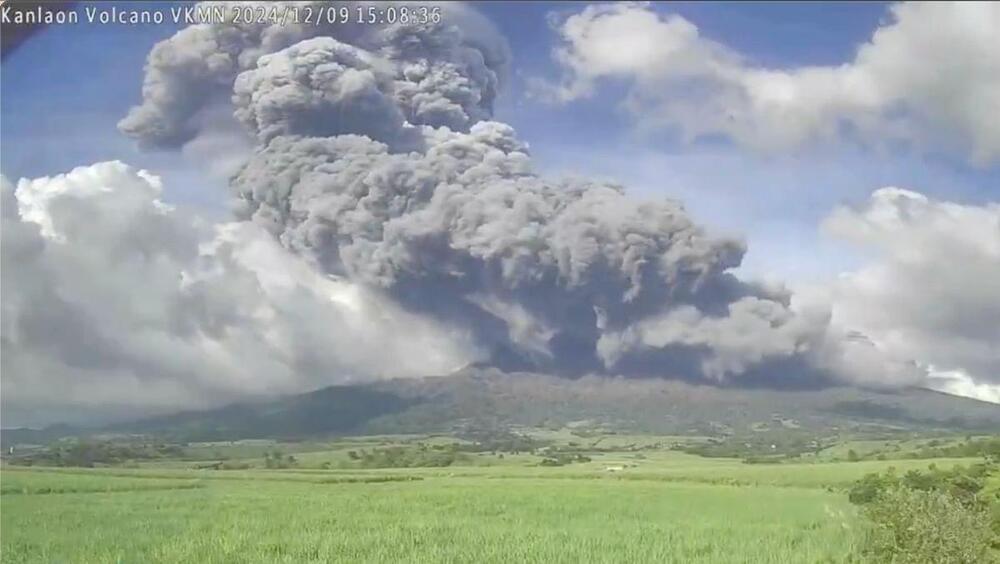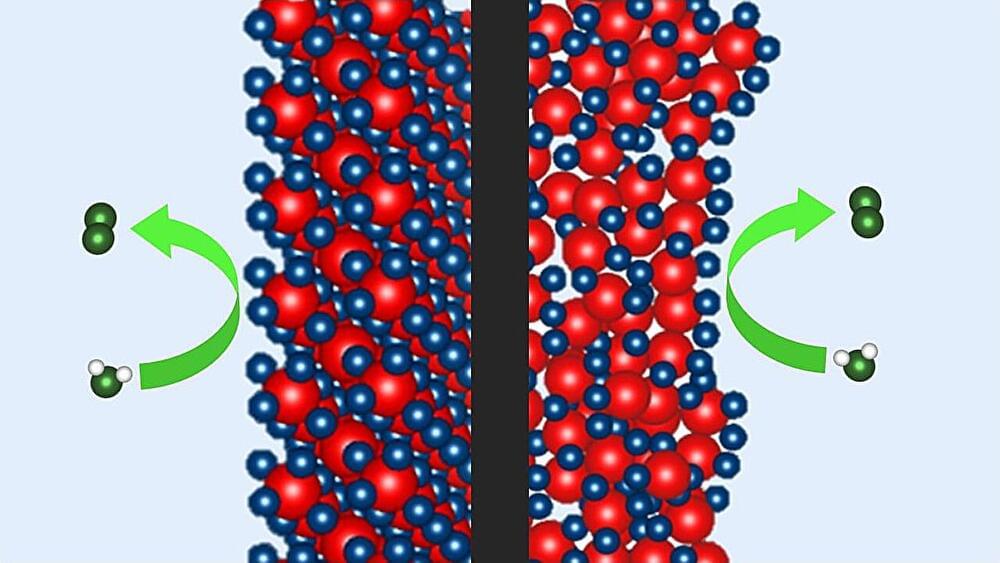Even spider love lives show an effect of climate uncertainty: Stressed males may offer a bit of silk-wrapped junk rather than a tasty insect treat.



Avalo, a crop development company based in North Carolina, is using machine learning models to accelerate the creation of new and resilient crop varieties.
The traditional way to select for favorable traits in crops is to identify individual plants that exhibit the trait – such as drought resistance – and use those plants to pollinate others, before planting those seeds in fields to see how they perform. But that process requires growing a plant through its entire life cycle to see the result, which can take many years.
Avalo uses an algorithm to identify the genetic basis of complex traits like drought, or pest resistance in hundreds of crop varieties. Plants are cross-pollinated in the conventional way, but the algorithm can predict the performance of a seed without needing to grow it – speeding up the process by as much as 70%, according to Avalo chief technology officer Mariano Alvarez.


Earth In 2024: The International Space Station (ISS) has captured more than 825,000 images of Earth so far in 2024, documenting our planet’s changing landscapes. NASA has shared that over 5.3 million photos have been taken from the space station since it began operations, contributing significantly to studies of urban light patterns, lightning activity, and natural disasters. In 2024 alone, these images were instrumental in analysing 14 major natural disaster events, from hurricanes and floods to volcanic eruptions.
Expedition 71, one of the most prolific missions in the ISS’s history, contributed over 630,000 images, marking the highest number of photographs taken during a single mission.
According to NASA, the Crew Earth Observations (CEO) program is at the heart of this effort. Equipped with digital handheld cameras, astronauts photograph Earth from their vantage point 200 miles above the surface. The program focuses on documenting both human-induced changes — such as urban expansion and reservoir construction — and natural phenomena, including hurricanes and wildfires.

The Arctic is likely to become “ice-free” by midcentury—and could pass that grim milestone much sooner—unless much more is done to combat climate change.
By Chelsea Harvey & E&E News
CLIMATEWIRE | By the end of the decade, the Arctic Ocean could see its first ice-free day on record — even with modest levels of global warming.

An experiment more than 10 years in the making has delivered its first glimpse of the hurricane of particles whirring inside subatomic particles called neutrons, laying the groundwork to solve a mystery deep in the heart of matter.
Data from the Central Neutron Detector at the US Department of Energy’s Thomas Jefferson National Accelerator Facility (TJNAF) is already playing a role in describing the quantum map of the neutron’s engine.
“It’s a quite important result for the study of nucleons,” says Silvia Niccolai, a research director at the French National Centre for Scientific Research.

Iridium-based catalysts are needed to produce hydrogen using water electrolysis. Now, a team at HZB has shown that the newly developed P2X catalyst, which requires only a quarter of the iridium, is as efficient and stable over time as the best commercial catalyst. Measurements at BESSY II have now revealed how the special chemical environment in the P2X catalyst during electrolysis promotes the oxygen evolution reaction during water splitting.
In the future, hydrogen will be needed in a climate-neutral energy system to store energy, as a fuel, and a raw material for the chemical industry. Ideally, it should be produced in a climate-neutral way, using electricity generated from harnessing the sun’s or wind energy, via the electrolysis of water.
In that respect, Proton Exchange Membrane Water Electrolysis (PEM-WE) is currently considered a key technology. Both electrodes are coated with special electrocatalysts to accelerate the desired reaction. Iridium-based catalysts are best suited for the anode, where the sluggish oxygen evolution reaction occurs. However, iridium is one of the rarest elements on earth, and one of the major challenges is to significantly reduce the demand for this precious metal.

Envision a settlement where the sunlight that beams across Australia buoy on its vast outback powers millions of homes and industries across Southeast Asia. This is how the Australia-Asia PowerLink (AAPowerLink) is being realized: the longest sub-sea cable in the world, linking northern Australia to Singapore, presently is one of the all-time break-through renewable energy developments. By virtue of this mammoth solar farm with its advanced energy transmission technology, this ambitious vision will shape the future energy systems around the world while addressing some critical climate issues.
Taking enormous advantage from its plentiful sunlight, northern Australia houses the world’s biggest Solar Precinct in its Northern Territory gathering between 17–20 GW peak electricity, a size surpassing that of Australia’s largest coal-fired power station.
The project incorporates advanced storage of 36–42 GWh, supplying 800 MW to Darwin and 1.75 GW to Singapore. In addition to reducing emissions and electricity prices for the Darwin region, it creates a renewable energy export marketplace for the region and demonstrates the use of the solar-rich area to meet 15 percent of Singapore’s electricity demand.

How much does sulfur emitted by marine life cool the atmosphere and help mitigate the effects of climate change? This is what a recent study published in Science Advances hopes to address as an international team of researchers conducted a first-time numerical analysis regarding the amount of sulfur is emitted by marine life and how much it cools the climate, with an emphasis on the Southern Ocean. This study holds the potential to help researchers, climate scientists, and the public better understand how the planet cools itself, thus enabling us to work together to protect it.
“This is the climatic element with the greatest cooling capacity, but also the least understood,” said Dr. Charel Wohl, who is a senior research associate at the University of East Anglia and lead author of the study. “We knew methanethiol was coming out of the ocean, but we had no idea about how much and where. We also did not know it had such an impact on climate. Climate models have greatly overestimated the solar radiation actually reaching the Southern Ocean, largely because they are not capable of correctly simulating clouds. The work done here partially closes the longstanding knowledge gap between models and observations.”
For the study, the researchers produced a database of ocean methanethiol concentrations with the goal of estimating their produced emissions and how this contributes to ocean-derived aerosols that are responsible for cooling the planet. In the end, the researchers discovered that methanethiol emissions increase the aerosol amount between 30 to 70 percent over the Southern Ocean while simultaneously decreasing atmospheric oxidants and increasing planetary cooling. The Southern Ocean is located around Antarctica and serves as a staging ground for the world’s oceans, influencing their circulation.
Professor Carlos Duarte, Ph.D. is Distinguished Professor, Marine Science, and Executive Director, Coral Research \& Development Accelerator Platform (CORDAP — https://cordap.org/), Biological and Environmental Science and Engineering Division, King Abdullah University of Science and Technology (KAUST — https://www.kaust.edu.sa/en/study/fac…), in Saudi Arabia, as well as Chief Scientist of Oceans2050, OceanUS, and E1Series.
Prior to these roles Professor Duarte was Research Professor with the Spanish National Research Council (CSIC) and Director of the Oceans Institute at The University of Western Australia. He also holds honorary positions at the Arctic Research Center in Aarhus University, Denmark and the Oceans Institute at The University of Western Australia.
Professor Duarte’s research focuses on understanding the effects of global change in marine ecosystems and developing nature-based solutions to global challenges, including climate change, and developing evidence-based strategies to rebuild the abundance of marine life by 2050.
Building on his research showing mangroves, seagrasses and salt-marshes to be globally-relevant carbon sinks, Professor Duarte developed, working with different UN agencies, the concept of Blue Carbon, as a nature-based solution to climate change, which has catalyzed their global conservation and restoration.
For the past years, Professor Duarte has also lead efforts to quantify the global role and importance of algal forests. He has conducted research across all continents and oceans, spanning most of the marine ecosystem types, from inland to near-shore and the deep sea and from microbes to whales, and has a particular focus on the role of seaweed aquaculture as a sustainable solution for multiple challenges.
Professor Duarte led the Malaspina 2010 Expedition, including over 700 scientists from 38 institutions from across 18 nations, that sailed the world’s oceans to examine the impacts of global change on ocean ecosystems and explore deep-sea biodiversity.